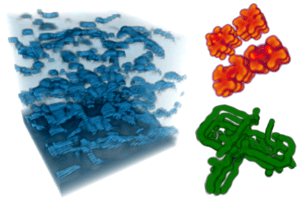 One approach to simulating natural phenomena is to
solve equations that describe their global behavior. Coupled
map lattice models, instead of solving for the global behavior
of a phenomenon, model the behavior by a number of very simple
local operations. When aggregated, these local operations produce
a visually accurate approximation to the desired global behavior.
One approach to simulating natural phenomena is to
solve equations that describe their global behavior. Coupled
map lattice models, instead of solving for the global behavior
of a phenomenon, model the behavior by a number of very simple
local operations. When aggregated, these local operations produce
a visually accurate approximation to the desired global behavior.
A coupled map lattice is a mapping of continuous
dynamic state values to nodes on a lattice that interact (are
‘coupled’) with a set of other nodes in the lattice according
to specified rules. Coupled map lattices were developed by
Kunihiko Kaneko
for the purpose of studying spatio-temporal dynamics and chaos.
Since their introduction, CML techniques have been used extensively
in the fields of physics and mathematics for the simulation of a
variety of phenomena, including boiling, convection, cloud formation,
chemical reaction-diffusion, and the formation of sand ripples and dunes.
|

